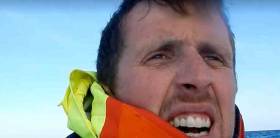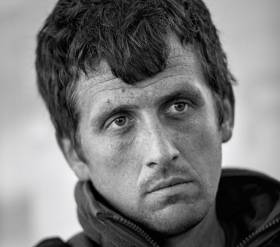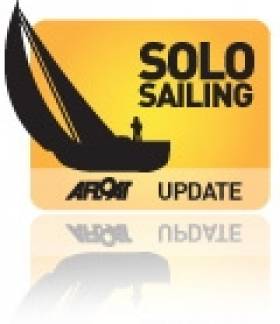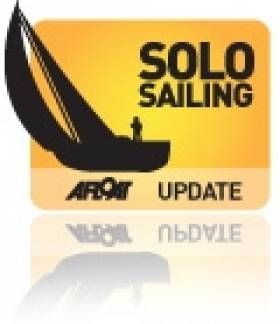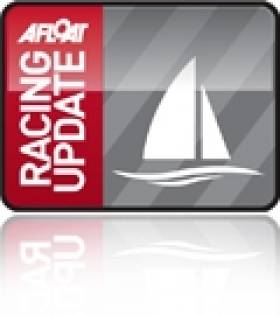Displaying items by tag: solo sailors
Tom Dolan Solo Video From 500-mile Mini-en-Mai Race
After Ireland’s Tom Dolan slipped to second in the 500-mile Mini-en-Mai in the last 30 miles last Friday he shared his frustration in a searingly honest analysis of his performance. Now he has put together a video (below) from race footage to give another unique insight into his race. He say's it's the 'full version' of what went on in the Mini en Mai 2017 and how, in his words, he 'made a hames of it'.
'I still haven't become much of a cameraman or filmaker and it's a bit of a long one but voila for those who want to see a bit what it's like during a race and the intense competition there is between us', he says. 'Sorry in the middle I switch a bit into Frenglish'. 'It was the fatigue', he concludes.
Keep up to date on Tom Dolan's progress towards this October's Mini Transat in Afloat.ie's dedicated solo sailing section here.
The world of sailing has so many sectors of interest that it’s challenging keeping track of the general picture. But even when you’ve achieved that basic level of comprehension, you then discover that each sector has so many sub-sectors that it all slips back into confusion. Once upon a time, W M Nixon though he’d a handle on the world of offshore racing. Now, he’s not so sure.
It’s all Tom Dolan’s fault. Most of you will know Tom as the farmboy from Meath who is cutting a remarkable swathe through the world of French Minitransat racing. Last week his name was back up in lights yet again after taking third in a fleet of 52 Minitransat boats in the 300-mile Pornichet Selector, which had these mighty atoms pinging up and down along France’s Biscay coast, with our man being overall leader at two stages.
He’s our Meath man now rather than a Meath farmboy, as he turned 30 on April 27th just after the race had finished. But he still has total boyish enthusiasm for the whole business, allied to a dogged yet adult dedication which is at such a level that it puts him on a different planet from most of the rest of us.
The plan for today was a quick look at Tom and what he’s doing as part of a general overview of the gradual regeneration of offshore racing and its various new areas of rapid development. But the problem is that, once you’ve sensed Tom’s enthusiasm and grasped just how utterly off the wall is his way of life, it takes over the whole show. So we’ll allow it to do so after a quick overview of the general scene.
And where better than to start with a quote from another man from Meath? We’ll always cherish the headline from The Meath Chronicle, when news of a certain sailing event in 1996 percolated through to the editorial headquarters of that esteemed journal in Navan:
LOBINSTOWN MAN WINS ROUND IRELAND YACHT RACE. That’s what it said. Real fame at last. Those of us who have a vague idea of Lobinstown’s location up near Nobber would have guessed it to be in Louth or even Monaghan. But not so, it’s clear over the border, into the Royal County and Meath Chronicle territory, and the Lobinstown man was Michael Boyd, who’d just knocked off the overall win in the big one with his J/35 Big Ears.
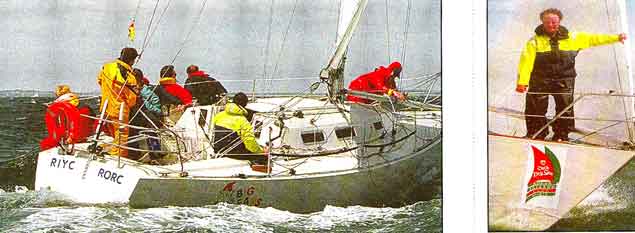 It’s 1996, and Michael Boyd’s J/35 Big Ears has just won Wicklow’s Round Ireland Race while her skipper (right) has become one of the earliest Afloat “Sailors of the Month”
It’s 1996, and Michael Boyd’s J/35 Big Ears has just won Wicklow’s Round Ireland Race while her skipper (right) has become one of the earliest Afloat “Sailors of the Month”
For that, he was our “Sailor of the Month” in the inaugural year of the contest, when we began to learn that monthly achievements, clearly highlighted at the time, amount to a very useful quick-reference history of Irish sailing years later. For the record, back in 1996 Big Ears was skippered by Michael Boyd with Jamie Boag (then 25) on navigation, tactics and alternate watch leader, Patsy Burke was relief helm and bowman, Brian Mehigan was bowman, ship’s doctor and cook, trimming team were P J Kennedy, David McHugh, Tim Greenwood and Michael Moloney, and Niall Dowling of the RIYC prepared the boat for the race.
Michael Boyd’s “Sailor of the Month” write-up also told us he’d done the Sydney-Hobart in 1993, the Newport-Bermuda in 1994, and the Fastnet in 1995, so with the Round Ireland won in 1996, you’d think that might be mission accomplished. But things were only getting going, and twenty years later he was back again – after much offshore racing since including being a winning co-skipper in the Irish Commodore’s Cup Team of 2014 – to race as Commodore Royal Ocean Racing Club in the 2016 Volvo Round Ireland Race, skippering the First 44.7 Lisa in which he was to finish third overall, and best Irish boat.
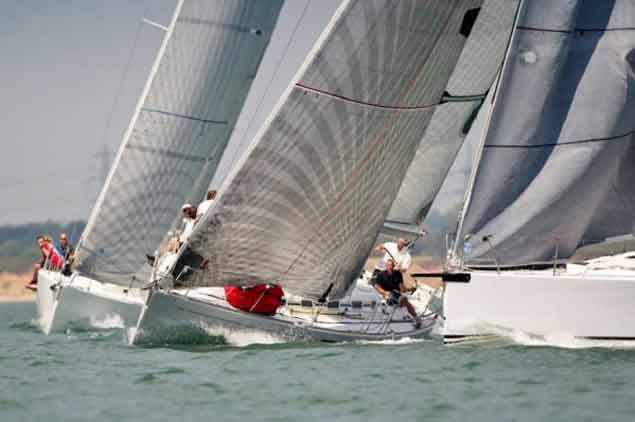 The First 44.7 Lisa at the start of the Volvo Round Ireland Race 2016
The First 44.7 Lisa at the start of the Volvo Round Ireland Race 2016
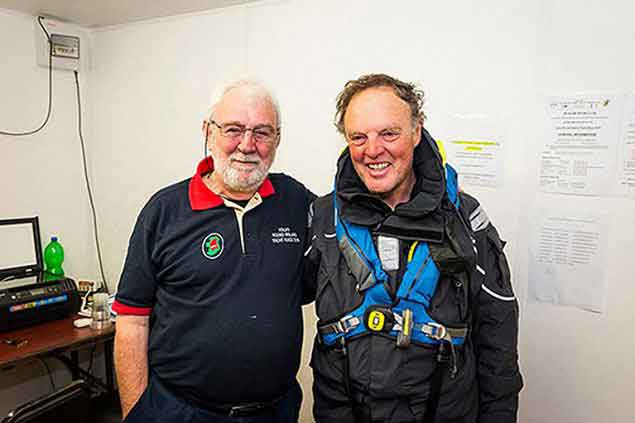 Race organiser Theo Phelan around midnight in Wicklow with Michael Boyd when the latter had just finished the Volvo Round Ireland Race 2016 to place third overall.
Race organiser Theo Phelan around midnight in Wicklow with Michael Boyd when the latter had just finished the Volvo Round Ireland Race 2016 to place third overall.
Since then he has linked up with the JPK 10.80 Audrey for racing in Ireland, but he continues to make the scene with the core RORC programme in the English Channel with the First 44.7 Lisa, and last weekend he was one of a goodly fleet in the seasonal opener, the Cervantes Trophy from Cowes to Le Havre, with a very strong French contingent taking part.
0ne of them, the J/133 Pintia skippered by top French sailor Bruno Trouble, won overall from a fleet which reflected the fact that IRC continues to give very good racing for boats of all sizes, types and – in some cases – quite significant ages, as the J/133 dates from 2006, second by just 6 minutes was the Swan 44 Pomeroy Swan (Paul Kavanagh), third was Noel Racine’s regularly campaigned JPK 10.10 Foggy Dew, and fourth was the veteran Swan 55 yawl Lulotte (Ben Morris).
As for Lisa with Michael Boyd, she’d a good race, coming second to Pintia in Class 2, and ninth overall in a fleet of 84 starters. That looked like a pretty good turnout for the time of year, so Afloat.ie tracked down the Commodore of the RORC during the week to see did he share our feeling that there really is a new buzz to the offshore scene, and he responded with enthusiasm:
“Our sport seems to be in rude health these days, with much positive news to report. A Rolex Fastnet Race year always brings out many boats for the summer season. In last weekend’s Cervantes Race, RORC welcomed 84 starters, twice the 2016 figure, and 78 of them made it to Le Havre, more than four times last year’s number when a shocking squall had quite an impact.
Particularly gratifying are marked increases in women and young people taking part. And at home, the numbers are up for the Dun Laoghaire to Dingle race, and ISORA’s revival is a source of continuing joy. Long may it continue!”
-Michael Boyd, May 4th 2017
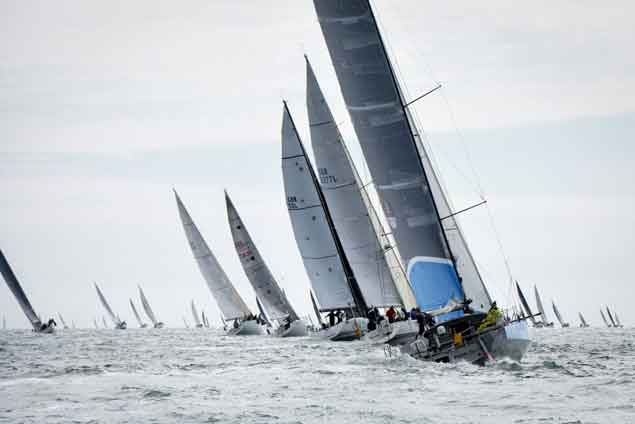 Last weekend’s RORC Cervantes Trophy Race from Cowes to le Havre attracted 84 starters – double the 2016 entry – and Lisa placed second in Class 2 and 9th overall. Photo RORC/Rick Tomlinson
Last weekend’s RORC Cervantes Trophy Race from Cowes to le Havre attracted 84 starters – double the 2016 entry – and Lisa placed second in Class 2 and 9th overall. Photo RORC/Rick Tomlinson
In such a mood of goodwill, Afloat.ie didn’t delve too deeply into other interesting developments within the energetic RORC machine, where Dr Jason Smithwick – who has an impressive background in academia, the research industry, and international sailing administration - will be taking over the key role in administering the IRC. Nor indeed did we enquire further into last week’s rumour that our own Marcus Hutchinson is quietly working behind the scenes to bring about a rapprochement between the IRC and the ORC. Because the fact is, the season is upon us, and for the next three months, the business of racing is top of the agenda.
In the Irish Sea it has been at the top since April 22nd, when ISORA’s opening day saw season-starting coastal races on both sides of the Channel, with the Irish side doing best in turnout, 22 boats starting at Dun Laoghaire and finishing at Wicklow, with Andrew Algeo’s J/109 Juggerknot taking the honours.
It’s thanks to the dogged enthusiasm of people like Stephen Tudor in Pwllheli and Peter Ryan in Dun Laoghaire that ISORA has been kept going to be ready and waiting for the renewed interest in offshore racing. This new enthusiasm stems in part from a reaction against the pattern developing the major cruiser-racer regattas, where some race officers pride themselves on fitting in two or even three races in a day.
For those of the offshore racing frame of mind, one or two starts in a week is quite enough, thank you, and they like their races to take long enough to settle down and develop a character of their own. The feeling among such folk is that modern life ashore is often a case of trying to cram as many starts as possible into each day, and they only find genuine relaxation in an alternative challenge which is taken in a very different kind of time frame.
That – more or less – is the explanation given recently by someone who has succumbed to the charm of the modern ISORA programme, which has become so user-friendly that it even includes Howth’s Lambay Race on June 3rd. Admittedly it has a slightly lower points rating of 0.9, but with 35 miles to be sailed by the big boat classes, it is indeed a miniature offshore race, and one which at times give the taste of the sport at its best in terms of amateur enjoyment and a change from the hassles of shore life.
Thus although they’re both under the broad umbrella of offshore racing, there really could be no greater contrast than that between the sailing of your average ISORA enthusiast, and the sailing of Tom Dolan on the Minitransat circuit.
Growing up on a little farm beyond Kells in County Meath, one day Tom and his father got the notion of going sailing on the picturesque Lough Ramor just up the road, so they bought themselves a sailing boat of sorts in County Roscommon and – self-taught – they did indeed find that sailing had something for them.
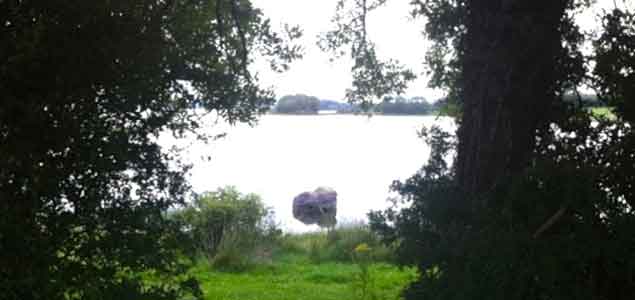 A long way from Concarneau.....Tom Dolan first discovered sailing on Lough Ramor.
A long way from Concarneau.....Tom Dolan first discovered sailing on Lough Ramor.
Even though the urge lay dormant in young Tom for his school years in Mullingar when Gaelic football and soccer took over his life, it was when he was 19 and at the outdoor activities education establishment Colaiste Dhulaigh, which is spread over four locations in Dublin and Malahide, that the sailing bug emerged again with an introduction to Glenans in Baltimore, and this time he was hooked for real.
Not only was he a natural sailor who was avid to learn more, but he proved to be a brilliant coach. There were others who realized that Tom Dolan was putting even more into sailing than he was taking out of it, and firm friendships were made, none firmer than that with Gerry Jones, who continues to live in Ireland where he has a busy working life. But he also acts as a voluntary agent for Tom, who in 2009 began to get involved in the sailing scene in France, and has steadily increased that involvement until he is now a leading figure in the Ministransat 650 programme.
It is by no means a gilded path he has chosen. Thirty million people in France may be closely interested in sailing, and they’ll take you to their Gallic hearts as you become part of their sailing scene. But the only sailing the Irish general public take much real interest in is the Olympics, and that’s when a medal may be in prospect. So an Irish rookie with very limited resources trying to get on the ladder in France – which is the only real ladder for high level offshore racing – has several mountains to climb.
But he knew what had to be done, and he knew how he could do it, for by this time he was being drawn into the 10-boat Minitransat community in Concarneau, which is well established as the CEMC (Centre d’Entrainement Mini de Concarneau). It sounds rather grand, but every cent has to be counted, and all involved are constantly looking for ways to increase income, maximise the boat’s performance, train and train again, and race.
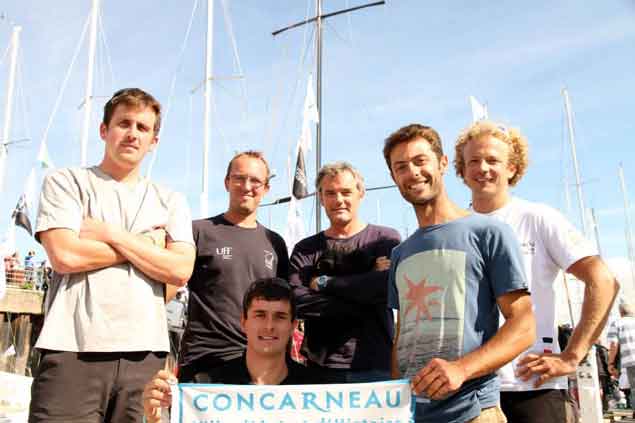 Members of the CEMC group at Concarneau, Tom Dolan on left
Members of the CEMC group at Concarneau, Tom Dolan on left
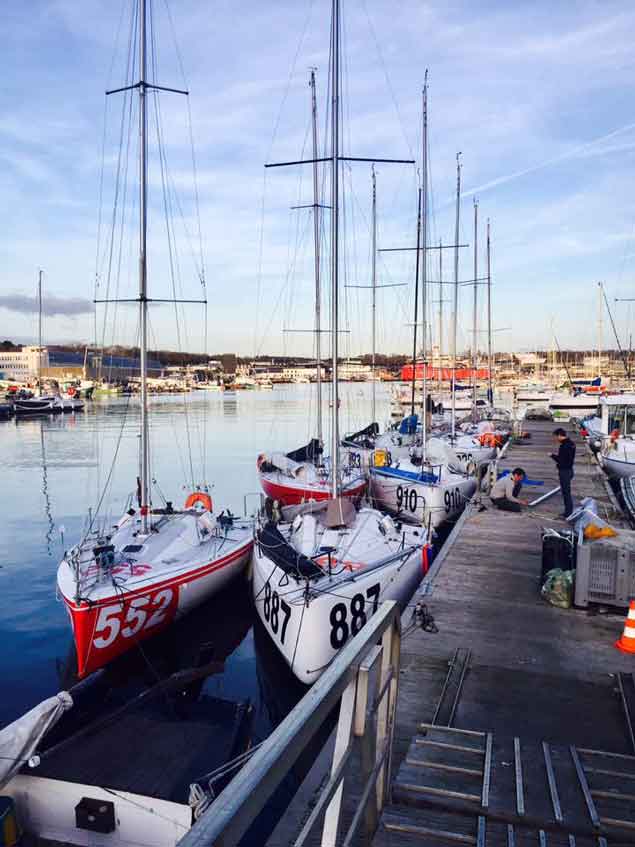 The Minitransat 650s of CEMC at Concarneau – Tom Dolan’s Pogo 650 Mark 3 (new in 2016) is number 910
The Minitransat 650s of CEMC at Concarneau – Tom Dolan’s Pogo 650 Mark 3 (new in 2016) is number 910
It’s worth it, as they have the great Gildas Mahe as coach, and last year every major race was won by one of the Concarneau group, including a victory for Tom himself. But getting to this level involved making a living doing deliveries and anything else involving high seas expertise, and using a borrowed Pogo 2 for his inaugural full season in 2015.
The Pogo 650 started life in 1995, and she’s now into Mark 3, one of the mainstays of the entire Minitransat scene. By 2015, the Mark 2 was off the pace, but Tom Dolan stuck at it to gain experience, and it was his father, with whom he’d shared those first sailing moments on Lough Ramor so many years ago, who made it possible to move on. For on his death in 2011, while the family farm was kept, he left Tom a modest legacy, and young Tom decided to blow the lot on getting involved with his own boat, and placed an order for the most basic available version of the Pogo 650 Mark 3.
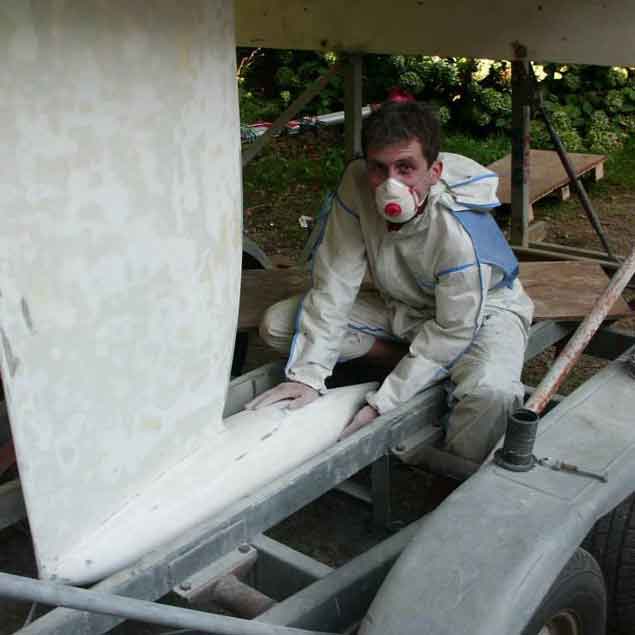 Tom getting the keel bulb perfectly faired. Members of CEMC expect to do most of their boat work themselves
Tom getting the keel bulb perfectly faired. Members of CEMC expect to do most of their boat work themselves
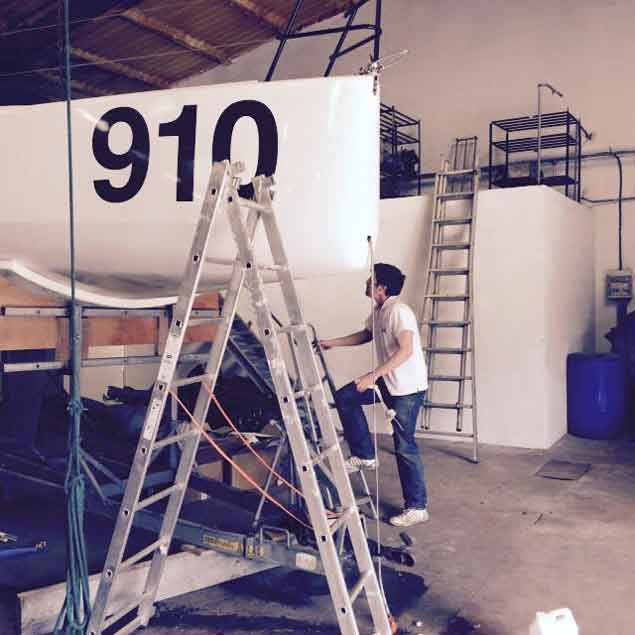 Commissioning the new 2016 boat – IRL 910 – basically involved Tom in fully equipping a bare shell.
Commissioning the new 2016 boat – IRL 910 – basically involved Tom in fully equipping a bare shell.
He had much to do with installing electrics and equipment and just abut everything else from scratch before his new boat was ready to go racing in 2016, but it was well worth it, and by season’s end he was feted in the local press and internationally as “The Flying Irishman”. To keep the show on the road, he and his friend and fellow-skipper Francoise Jambou run their own 650 Training Centre which, with Tom’s brilliant coaching talents, provides a useful stream of income.
But as the sailing level escalates, so do the costs, and he’s very appreciative of sponsorship from home in the shape of Dubarry Ireland and Ding, while the strength of French interest in sailing generally is shown by support from Cellastab, Techniques Voiles, Renostye, Studio des Schizographes and of course his local pub, the Petite Bistro, where he’ll be celebrating the third place in the Pornichet Select 300 tonight, and maybe a toast to success in next Tuesday’s 500 miles race.
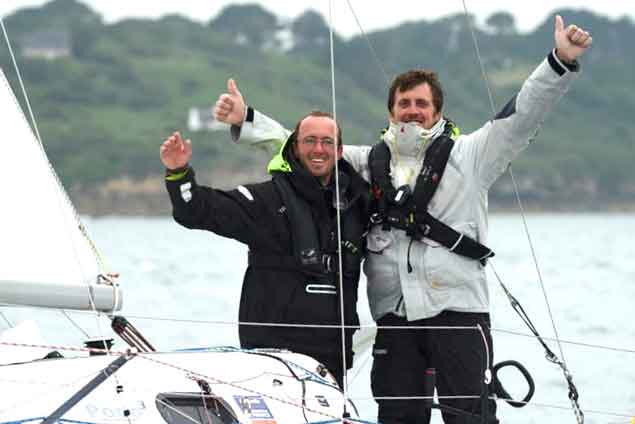 Tom Dolan (right) with sailing partner Francois Jambou celebrating victory with the new boat in a two-handed race.
Tom Dolan (right) with sailing partner Francois Jambou celebrating victory with the new boat in a two-handed race.
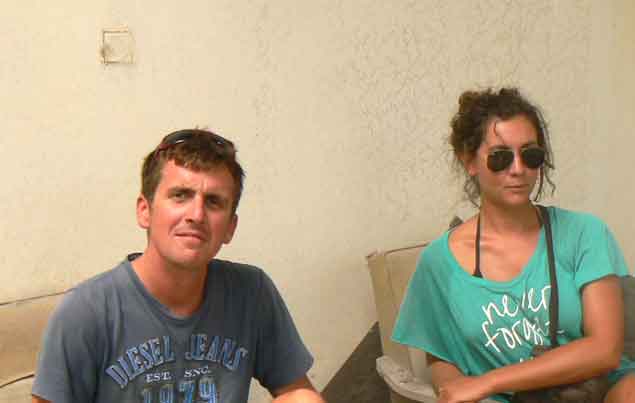 Tom from Meath and Karen from Lyons in Montserrat, where he’d sailed on a delivery voyage
Tom from Meath and Karen from Lyons in Montserrat, where he’d sailed on a delivery voyage
As for what it’s like being Concarneau-based on a year-round basis, even with the camaraderie and constant work and training of the CEMC, the winters can be long enough if you don’t line up a sunny delivery trip now and again. It was after one of these to the Caribbean and Montserrat that Tom met the significant other, Karen from Lyons, so now life back in Concarneau has a certain domesticity to it that was formerly lacking.
That said, domesticity is of a very rationed variety when you’re into sailing at this level, and Tom Dolan’s proposed programme for 2017 shows his level of commitment, and the continuing requirement for a solid sponsorship package, as the countdown to the Minitransat on October 1st at La Rochelle continues.
22nd April: Pornichet 350 Select (placed 3rd out of 52 boats)
May 9th Mini en Mai 500 miles
June 8th Trophee Marie-Agnes Peron
June 18th Mini Fastnet 600 miles (two-handed with Francois Jambou)
July 30th Transgascogne
October 1st Mini Transat (from La Rochelle)
Even as the programme is being implemented. Tom Dolan’s supporters behind the scenes are beavering away to put together a support package which will make the Mini-Transat a properly resourced challenge.
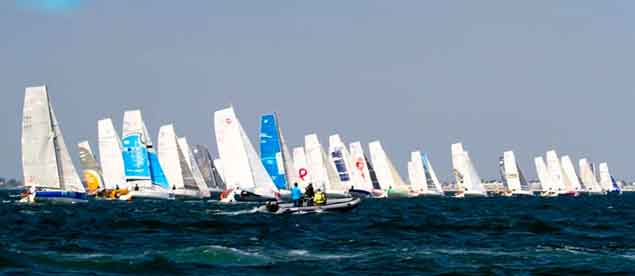 The contemporary French fleet of 52 actively-campaigned Mini 650s is an impressive sight on the starting line.
The contemporary French fleet of 52 actively-campaigned Mini 650s is an impressive sight on the starting line.
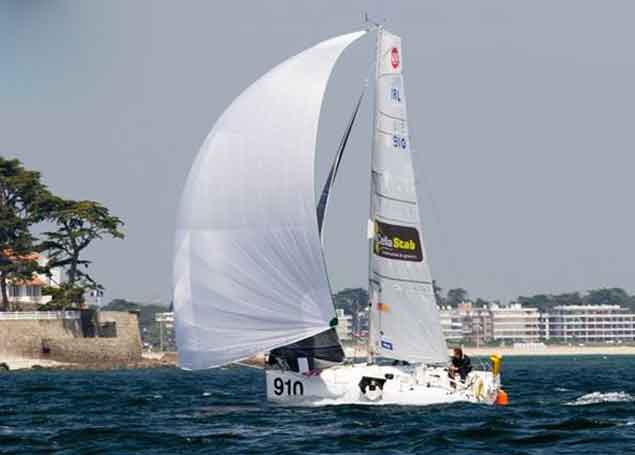 Getting clear and getting ahead – IRL 910 departs Pornichet
Getting clear and getting ahead – IRL 910 departs Pornichet
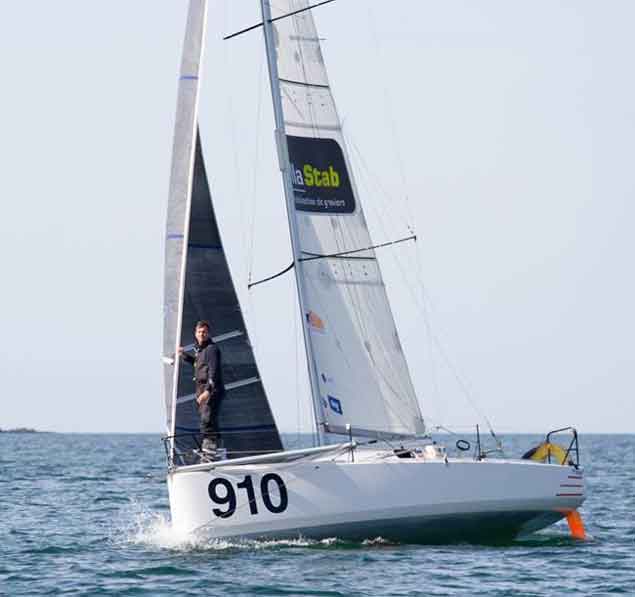 After being in the lead within five miles of the finish of the 300-mile Pornichet Select on April 26th, Tom Dolan in IRL 910 had to be content with third in the fleet of 52 at the finish.
After being in the lead within five miles of the finish of the 300-mile Pornichet Select on April 26th, Tom Dolan in IRL 910 had to be content with third in the fleet of 52 at the finish.
And beyond that? Team Tom Dolan are very interested in the confirmation of a decision which is expected to come from the Mid-Year Meeting of the World Sailing Council which is currently under way in Singapore (from May 5th to May 9th). Before it is the final acceptance of an invitation from the International Olympic Council to World Sailing to propose Showcase Events to be held alongside the Sailing Olympiad 2020 in Tokyo to demonstrate the potential of both kiteboarding and offshore racing to be Olympic events.
For offshore racing, the proposal is already taking shape for a 9-12m totally One-Design boat, to be raced two-handed, the fleet for the Showcase Event at Tokyo being envisaged at 18 to 20 boats. It’s emphasized that this is only a showcase, it’s not real Olympics. But it could be a guide for the future, and we’ve no doubt that if such an event were to be held in 2020 beside the Olympics, the participants would regard it as very much for real.
It’s certainly of considerable interest to Tom Dolan and his team, for they’re very aware that you’re in a different league in Ireland when you’re trying to raise support for an Olympic campaign rather than something which is seen as more of a niche interest.
But quite what your traditional offshore racer, setting off in their favourite ISORA or RORC event, will think of the prospect of their beloved sport being sucked down into the Olympic maelstrom is something else altogether - a topic for another day
84 Entries for Mini Transat, Recession Proves No Barrier
#minitransat – The small business that is the Mini does not recognise the crisis. Once more the race for these boats of just 6.50 meters was refuelled, on 30 August, with 84 competitors admitted who had met the full requirements of the organiser and the Mini class. From the semi-professional racer to the businessman on leave and with competitors from nearly every continent, the entry list presents an incredible diversity.
All being well there will be 84 boats at the start and at the moment a dozen navigators still remain on the waiting list eager to find out if they will have the chance to race. Among the final list of entries, there are several who not to have yet confirmed their full funding and on the deadline of September 13, all registration fees (2000 €) must be paid to the organiser. It is therefore likely that the list is still evolving over the next two weeks, after a few withdrawals of candidates who do not have the means to start.
Note also that there are 32 foreigners, from Estonia to Australia, who will come to the start so Douarnenez will resonate with a multitude of accents at the beginning of October.
Runners by vocation and unlikely trades
As always, there are those for whom the Mini Transat is a springboard for a career in professional sailing. Latest to have qualified as a result of their participation in the Transgascogne is Nicolas Boidevezi, the brilliant winner of the Les Sables - Azores - Les Sables in 2012, and Julien Pulvé who, despite a late entry, intends to shake up the hierarchy of favourites.
But others swap their civilian clothes for foul weather gear. Louis Mauffret, Sales Manager of Chantiers du Guip, steps over with some ease from the world of traditional boats, while in the prototypes Yann Le Pautremat abandons his work as a dentist to cross the ocean. David Genest, meanwhile, works as a steeplejack in Paris. He spends his time climbing the facades of buildings for maintenance, or for any mission that requires specialists climbing and rope access skills.
Port Rhu Live: events and exhibitions for 10 days in October
While the competitors are putting the final touches to their preparation, the town of Douarnenez is being mobilized for a wonderful celebration. The 84 boats will be moored from 3 to 13 October 2013 in Port Rhu at the foot of the Place de l'Enfer so that the public can benefit from this arena to open sea where they can admire the fleet.
The Port Musée also participates in its own way by opening a new exhibition on the history of the Mini Transat and what it has brought to the world of racing: fostering some of the greatest offshore racers such as Jean-Luc Van Den Heede, Loick Peyron, Marc Guillemot and Michel Desjoyeaux, the Mini Transat was a true indication of talent. But the Mini is also the starting point for a number of technological innovations, many of which have been later used in the Vendee Globe. Finally, it is a real mix of cultures and backgrounds. The exhibition will open on October 5 and will continue until 17 March 2014.
Douarnenez will strive to share with the public the unique flavour of the Mini Transat, as during the ten days before departure, from 3 October, the fleet will be in full force in the Port Rhu. The prologue of the race will take place on 6 October, in the Bay of Douarnenez, with the contours of the Menez Hom in its glorious fall colours as a spectacular backdrop. For a week, until the great departure, the Mini Transat Village will host partner booths, themed exhibitions and numerous street entertainments. On 5 and 6 October the Port Musée will host a concert of classical music and on 9 October there will be jazz.
In a nutshell, Douarnenez is the place to be in early October if you don't want to miss one of the most beautiful moments in offshore racing.
The course 2013: returns to its origins
Leg 1 - Douarnenez to Arrecife (Lanzarote): 1200 miles.
Leg 2 - Arrecife to Pointe a Pitre: 2800 miles.
Dates
Prologue October 6, 2013.
Start from Douarnenez October 13, 2013 at 13h. Arrival in the Canary Islands between 23 and 26 October 2013.
Start from Canary Islands November 9, 2013. Arrival in Guadeloupe between 23 and 30 November 2013
Solo Sailor Embarks on North Atlantic Record;5 days,19 hours, 30 minutes & 40 seconds
The French sailor, Francis Joyon is due to set off early today (Tuesday 11th June) to tackle the solo Atlantic crossing aboard his maxi trimaran IDEC. He is expected to cross the official starting line at the foot of Ambrose Light off New York between 0000hrs and 0600hrs GMT (0200hrs – 0800hrs CET). He will be facing the Atlantic alone all the way to the Lizard at the southernmost tip of Cornwall and is hoping to complete the voyage in less than 5 days, 19 hours, 30 minutes and 40 seconds in order to have his name added to the registers of the World Speed Sailing Record Council in place of the current holder, Thomas Coville. Francis Joyon would achieve two success in one, if he does this. He will be regaining a title that was his until 2008, and above all will become the only man to hold the four most important solo sailing records, the Round the World Record, the 24-hour distance record, the Columbus Route record and the North Atlantic record.
A decent weather opportunity
"The weather opportunity tonight is looking decent," according to Jean-Yves Bernot, the leading light in ocean racing navigation, who continues to assists Francis Joyon is his major sailing challenges. To put it simply, the conditions are looking favourable, if not ideal, but are decent enough to allow him to make this attempt. Back in France, the two men had been watching a low-pressure area develop over the continent of North America, offering the strength and trajectory that suits this record, which over the years has become increasingly difficult to beat. During the weekend, Francis Joyon was more and more certain of the situation and decided to climb aboard a plane yesterday to head for New York, where he will get back with his giant trimaran IDEC, currently moored in Gateway Marina in Brooklyn, New York.
A possible start at between midnight and six (GMT)
The hulls will be cleaned, the final supplies stowed aboard, and as usual, everything will be done all by himself. Joyon will run through the final details about the weather situation tonight with Jean-Yves Bernot, before setting off on the perilous journey to the starting line and the former site of the legendary Ambrose Light at the entrance to the bay off New York. The light itself was removed in 2008 after a series of collisions, and has now been replaced by a set of lit buoys. If he sets off between midnight and six (GMT), he will be able to make the most of the daylight to cover the tricky miles sailing his boat up out of the river. The low that is passing over Labrador should allow him to sail along in steady thirty-knot winds blowing from the east-south-east on seas that should be easy to deal with for at least the first two-thirds of the course. As is often the case in these record attempts, it is the final phase, as they approach the British Isles, which are the most uncertain. The winds are likely to strengthen towards the end of the week, making it more complicated for the solo sailor. However, with the low moving along fairly high up to the north, it should allow IDEC to stay close to the direct route, and therefore get the best trajectory towards the Channel approaches, and sail along efficiently towards the Lizard.
New York – The Lizard, 2880 theoretical nautical miles (or 5334 km).
Solo North Atlantic records
1987: Bruno Peyron, Explorer catamaran, in 11 days, 11 hours 46 minutes and 36 seconds
1990: Florence Arthaud, Pierre 1er trimaran, in 9 days, 21 hours and 42 minutes
1992: Bruno Peyron, Explorer catamaran, in 9 days, 19 hours and 22 minutes
1994: Laurent Bourgnon, Primagaz trimaran, in 7 days, 2 hours, 34 minutes and 42 seconds
2005: Francis Joyon, IDEC 1 trimaran, in 6 days, 4 hours, 1 minute and 37 seconds
2008: Thomas Coville, Sodebo trimaran, in 5 days, 19 hours, 29 minutes and 20 seconds
The three major solo records already held by Francis Joyon aboard IDEC
2008: Solo Round the World record in 57 days, 13 hours 34 minutes and 06 seconds
2012: Distance sailed in 24h: 666 miles at an average speed of 27.75 knots
2013: Columbus Route Cadiz-San Salvador: 8 days 16 h 07 minutes and 05 seconds.
All Round Fastnet in Normandy Channel Race
Having tacked down the southern seaboard of Ireland after rounding Tuskar Rock, all boats in the Normandy Channel Race have now rounded the Fastnet and are heading east on the homeward leg. The Normandy Channel Race is one of many that visit Irish waters without stopping, with the Mini Fastnet and others dipping into our territory to find a high-profile rock before fleeing again.
The 8 competitors are making for the Scilly Isles, a string of rocks scattered about the South-West tip of England. To the great delight of these sailors, the fog, which has been tenaciously clinging onto them for the past three days, is gradually dissipating the further South the Class 40s sail. However, little else has changed and they’re still canted over against the wind as they make headway towards the English Channel and Normandy.
Double-handers head for Tuskar
A fleet of top-class double-handers will streak across Ireland's south coast in the next two days as part of a 1,000-mile race beginning and ending in the French port of Caen. The Normandy Race sends the crews of Class 40s around the Tuskar rock and then on to round the Fastnet to Port before heading back toward France. The fleet has already navigated through the Solent, and in second position is a team including Michael Kleinjans, who set the Round Ireland single-handed record in his Class 40, Roaring 40.
The race can be followed online with the real-time tracker.


























